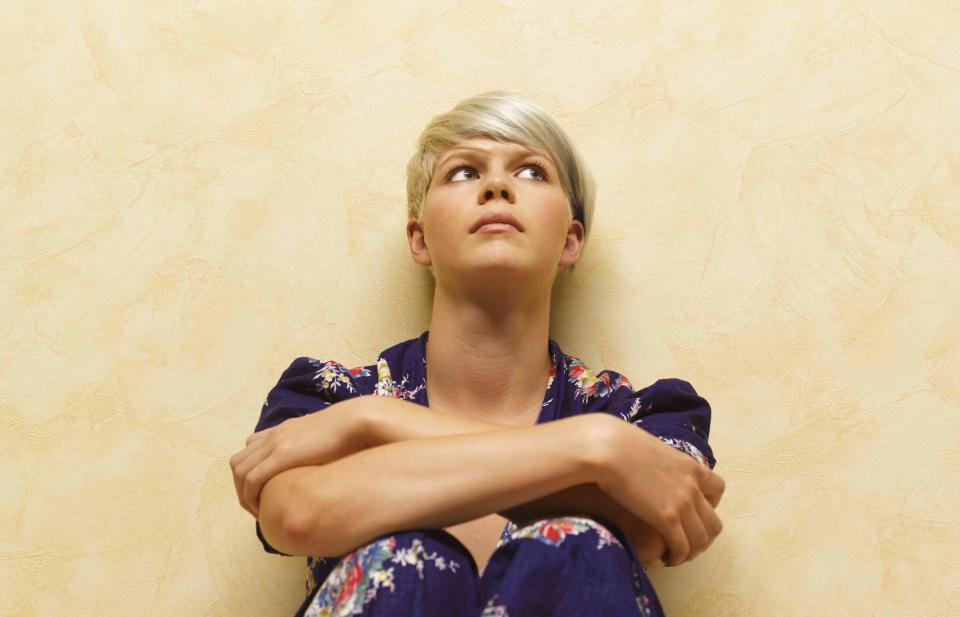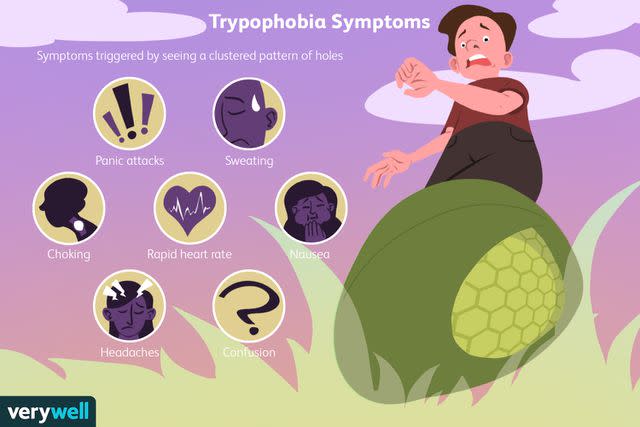What Is Trypophobia?
A fear of holes clustered together or repetitive patterns

Peter Dazeley / Getty Images
Medically reviewed by Steven Gans, MD
Trypophobia is an intense and disproportionate fear or disgust for holes, bumps, or patterns that are clustered together or repetitive. For example, this can be triggered by holes in a honeycomb or sponge, the skin of a snake, or the seeds on a strawberry.
Trypophobia is not officially classified as a mental disorder, though it can affect people negatively in different ways. For many people, the condition is mostly uncomfortable and not debilitating. While there is limited and contradictory research on whether it is indeed a true phobia, people with trypophobia may meet the diagnostic criteria for a phobia if they exhibit symptoms that interfere with everyday living.
In fact, people who exhibit severe symptoms may be treated with therapies commonly used for anxiety disorders, such as exposure therapy.
Trypophobia Triggers
Trypophobia can be triggered by a range of objects and patterns. These can be naturally occurring or manufactured.
For example, someone with trypophobia may be triggered by:
Lotus seed pods
Honeycombs
A cut pomegranate
Insect eyes
Sea sponges
Coral
Condensation on a surface
Bubble wrap
Metal mesh
Fishnet material
Lace
Reptile skin
Sponges
Raspberries
Bumps on the outside of a pineapple or jackfruit
Trypophobia can also manifest as an extreme aversion to patterns associated with certain skin conditions such as ichthyosis, which causes a diamond-shaped pattern on the skin.
People with trypophobia may be especially triggered by created images of human body parts superimposed with holes and other patterns. This may trigger trypophobia as an irrational fear of skin diseases or even a fear of holes in the hands or other body parts.
Is Trypophobia a Real Phobia?
Trypophobia wasn’t well known until recently. It is believed that the term trypophobia was first coined in 2005, when participants in an online forum claimed to have an unreasonable disgust or fear of objects with closely packed holes.
Since then, thousands of people have come forward claiming to be affected. This has led some experts to question whether trypophobia is a legitimate condition, or simply a socially influenced disorder, similar to Morgellons disease.
Usually, experts make a diagnosis of a phobia according to the criteria outlined in the Diagnostic and Statistical Manual of Mental Disorders, Edition 5 (DSM-5). However, it’s been difficult to determine if trypophobia meets the conditions for a specific phobia because researchers interpret the condition differently.
For example, one study published in Frontiers in Psychiatry in 2018 reported that many people claiming to have trypophobia exhibited disgust upon seeing clustered patterns, but not fear. These researchers ruled against classifying it as a phobia, since fear is a defining feature of phobias.
In contrast, the Brazilian Journal of Psychiatry published a report concluding that trypophobia is indeed a specific phobia. This was determined by the persistence of the symptoms, paired with the psychological stress and impairment study participants experienced.
Other researchers believe the initial disgust a person feels toward clustered patterns may begin as a fear, but with negative reinforcement and continued avoidance, can evolve into a phobia over time.
Symptoms of Trypophobia
Like other phobias, trypophobia manifests with both a psychological response and an autonomic nervous system response. These reactions accelerate a person’s negative experience, because extreme emotions spawn physical symptoms and vice versa.

Verywell / Laura Porter
People with trypophobia may experience some or all of the following physical and psychological symptoms:
Overwhelming feelings of anxiety
Sweating
Trembling
Hot flashes or chills
Shortness of breath
Choking
Rapid heartbeat
Nausea
Headaches and dizziness
Faintness
Numbness
Dry mouth
Confusion
People with phobias tend to avoid the object or experience that triggers symptoms, which can make it more difficult to function in certain circumstances.
Diagnosis
A further challenge to the diagnosis is that trypophobia can coexist with other psychiatric disorders (such as major depressive disorder, obsessive-compulsive disorder, generalized anxiety disorder, or other phobias), which can create an overlap in symptoms.
What Causes Trypophobia?
Phobias don’t have a specific cause. Instead, they can result from any number or combination of complex factors, including genetics, prior trauma, learned responses early in life, and long-term anxiety or depression.
With trypophobia, some scientists believe the cause may be evolutionary. Rather than being caused by trauma or anxiety, researchers at the University of Amsterdam suggest that trypophobia may simply be an “exaggerated and overgeneralized version of a natural adaptive response” to patterns in nature we inherently view as dangerous.
For instance, a person may subconsciously associate a bumpy object with rashes or blisters, such as those seen in smallpox. Clusters of holes may be interpreted as parasitic infestations of the skin, and certain patterns can mimic the appearance of venomous snakes.
Similarly, a person may fear clustered patterns on food and other organic matter because it mimics the appearance of maggots, which could make food dangerous to eat.
Other scientists are less supportive of the hypothesis. In a 2017 study, preschoolers exhibited an immediate aversion to colored photos of venomous snakes, but not to characteristic patterns associated with snakes. This suggests that any response to such patterns may be learned, rather than instinctual. It also raises doubt about whether or not trypophobia is a legitimate phobia.
Trypophobia Treatment
Trypophobia isn’t a specific condition, so there are no clearly established recommended treatments. However, people diagnosed with a specific phobia are typically treated with psychotherapy and, if needed, medications.
Treatments include:
Exposure therapy, which can reduce a person's response to fear by exposing them gradually to the thing they avoid and are afraid of.
Cognitive-behavioral therapy helps people address the negative thoughts, behaviors, and emotions that arise when they are exposed to their phobia, then replace them with feelings of safety and positivity.
Benzodiazepines are central nervous system depressants that can be used to relax someone who is experiencing stress, anxiety, and panic in response to a phobia.
Selective serotonin reuptake inhibitors help treat phobias by regulating serotonin, a brain chemical that plays a role in mood and anxiety.
Beta blockers can counteract the anxious effects of phobias by blocking the beta receptors. This slows the heart rate and helps lower blood pressure to reduce symptoms of anxiety. However, this medication is only helpful when taken prior to a known exposure to the feared element.
Takeaway
If you or a loved one are struggling with anxiety or a phobia, contact the Substance Abuse and Mental Health Services Administration (SAMHSA) National Helpline at 1-800-662-4357 for information on support and treatment facilities in your area.
For more mental health resources, see our National Helpline Database.
A Word From Verywell
Regardless of whether trypophobia becomes a recognized diagnosis by the Diagnostic and Statistical Manual of Mental Disorders, it can potentially be detrimental to daily life. Any overactive response to an object or situation that is persistent and triggers avoidant behaviors should not be ignored or minimized. You can get help by seeking a therapist or doctor who specializes in treating phobias and anxiety disorders.
A professional can help you discover different coping tools and treatments to find the one that’s right for you. Many people have phobias and irrational fears and are able to overcome them with the right kind of help. Talking openly with your loved ones about your fears can make events less intense and help you gather support in your healing journey.

